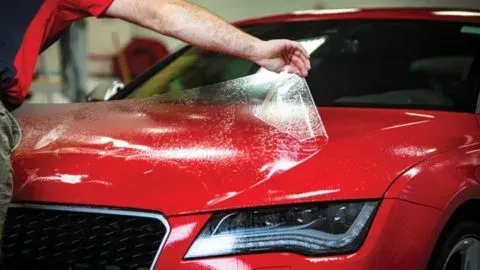Can Paint Protection Film Prevent Rock Chips?
Paint Protection Film (PPF) is a transparent, durable layer applied to a car’s exterior to protect it from physical damage, including rock chips, scratches, and minor abrasions. For car owners in Modesto, rock chips are an everyday nuisance. With heavy traffic on Highway 99, frequent construction zones, and debris from nearby agricultural areas, maintaining a flawless paint job can feel like an uphill battle.
That’s where working with a local expert makes all the difference. Not only do we understand the unique challenges of driving in Modesto, but we also offer tailored solutions to keep your car protected.
What Are Rock Chips and Why Are They a Problem?
Rock chips are small, sharp pieces of debris—like gravel, stones, or road salt—that get kicked up from the road and hit your car at high speeds. These chips may seem minor, but they can cause significant damage over time.
In Modesto, the risks are particularly high:
- Highway Driving: Regular travel on Highway 99 exposes your vehicle to a constant barrage of flying debris.
- Agricultural Zones: Dirt roads and farm equipment often leave gravel and other materials scattered on the road.
- Construction Areas: With ongoing development in and around Modesto, loose construction materials can easily find their way onto your car’s surface.
Beyond being unsightly, rock chips can lead to:
- Paint Damage: Tiny chips can penetrate your vehicle’s paint, leading to peeling and further deterioration.
- Rust and Corrosion: Once the paint layer is compromised, the exposed metal becomes vulnerable to rust, especially in rainy conditions.
How Does Paint Protection Film Work?
Paint Protection Film acts as a barrier between your car’s paint and the outside world. Designed to absorb and deflect impacts, PPF prevents rock chips from reaching your vehicle’s surface.
Here’s a breakdown of the film’s multiple layers and their functions:
- Topcoat Layer: Self-healing properties repair minor scratches and swirl marks when exposed to heat or sunlight.
- Polyurethane Layer: Provides impact resistance, absorbing the force from debris like rock chips.
- Adhesive Layer: Ensures a secure bond to your vehicle’s surface without damaging the paint beneath.
- UV Protection Layer: Shields your car’s paint from fading or discoloration caused by prolonged sun exposure.
Why is PPF Superior to Traditional Methods Like Waxing or Touch-Up Paint?
- Waxing: While wax offers some level of protection, it cannot absorb impacts or prevent scratches effectively.
- Touch-Up Paint: This is a reactive solution—only used after the damage has occurred. PPF, on the other hand, is proactive, stopping damage before it starts.
By investing in paint protection film, you’re not just preserving your car’s appearance; you’re also saving money on costly repairs down the line.
Benefits of PPF for Modesto Drivers
Paint Protection Film offers a range of benefits that make it a must-have for Modesto drivers. Whether you’re cruising through city streets or taking long trips on Highway 99, PPF provides peace of mind and long-term savings:
- Long-Lasting Protection: PPF offers superior resistance against rock chips, scratches, and other minor damages. It shields your vehicle from daily wear and tear, keeping your paint job in top condition for years.
- Cost-Effectiveness: While PPF may seem like a significant upfront investment, it pays off in the long run. You can avoid costly repainting or touch-up services, which can add up over time.
- Enhanced Resale Value: A car with a flawless exterior will fetch a higher resale price. PPF preserves the original paint, ensuring your car looks as good as new when it’s time to sell or trade it in.
Local Insight: Why Modesto Drivers Are Opting for PPF
In Modesto, road hazards are a daily reality. Several local factors contribute to an increased risk of damage to your vehicle’s paint:
- Construction Zones: The city’s ongoing infrastructure projects mean frequent encounters with loose gravel and debris.
- Agricultural Equipment: Modesto’s farming industry often leaves dirt and small rocks on the roads, which can be kicked up by passing vehicles.
- Weather Conditions: Sunny days followed by rainy periods can accelerate paint deterioration, especially if rock chips expose the metal underneath.
Many local drivers are choosing PPF as a proactive solution to these challenges, ensuring their vehicles remain in pristine condition despite Modesto’s road conditions.
Choosing the Right PPF Installer in Modesto
For PPF to deliver maximum protection, professional installation is crucial. Here’s what to consider when selecting a provider:
- Experience and Expertise: Look for installers with a proven track record in PPF application. Proper installation ensures a seamless finish and optimal performance.
- High-Quality Films: Not all PPF products are created equal. Premium brands offer better durability, self-healing properties, and UV protection.
Protect Your Car Today
Investing in Paint Protection Film is one of the best decisions you can make to preserve your vehicle’s look and value, especially in a place like Modesto, where road hazards are part of daily life. By shielding your car from rock chips, scratches, and other minor damages, PPF ensures that your paint stays flawless, maintaining your car’s aesthetic and resale value for years to come.
Our expert team https://www.fivestarautotint.com/uses only the highest-quality films and provides professional, seamless installations tailored to your needs. Don’t wait for damage to happen—protect your car now.









